Okay, ad revenue is the most obvious way to make money on YouTube. But it’s not the only way—or, to be honest, the best way.
(Spoiler: the best way to make money on YouTube is all the ways.)
YouTube is half the internet: that’s 1.9 billion users logging in every month. But at the same time, 500 hours of video are uploaded to the site every minute.
So you already know this article is not going to be about how easy it is to buy a Swiss watch with the ad revenue from your YouTube views. (Though if you have millions of views, you could probably at least rent one. Wait, don’t.)
Read on, and we’ll lay out six ways to earn income from your YouTube channel. Namely:
Become a YouTube Partner
Sell your own merchandise
Create sponsored content
Get your fans to pay you directly
Use crowdfunding on an ongoing or one-off basis
License your content to the media
And now for some step-by-step instructions for making money on YouTube.
Bonus: Download a free guide that reveals the exact steps one creator took to gain more than 23,000,000 views on YouTube with no budget and no expensive gear.
How to make money on YouTube
Become a YouTube Partner
The YouTube Partner Program is how regular YouTubers get access to special features on the platform.
You don’t need to be a partner to make money on YouTube (just setting up an AdSense account and getting views is enough to handle that), but being a Partner makes it a lot easier.
YouTube Partners have access to multiple income streams: not just ads, but YouTube Premium subscription fees, and features that tap your fans’ wallets directly like Super Chat, channel memberships and the merchandise shelf (more on these later.)
Step 1. Start a channel
Don’t worry, we have a handy guide for this. It’s called ‘How to create a YouTube channel.’
Step 2. Make your channel successful enough that it meets the YouTube Partner Program requirements
To join the program, you need a minimum of 1,000 subscribers and 4,000 watch hours in the previous 12 months.
Here are some ideas for how to get more of those precious YouTube views.
Step 3. Set up an AdSense account
This is simple. Just follow YouTube’s official guide to AdSense accounts.
Step 4. Explore your new monetization features
Each monetization channel has different eligibility requirements. For instance:
- Ad revenue: to earn ad revenue, you must be at least 18 years old, and you must create content that is advertiser-friendly. Basically, the less controversial your videos, the more YouTube advertisers will be comfortable running ads on them, and the more money you make.
- YouTube Premium revenue: if a YouTube Premium member watches your video, you get a portion of their subscription fee. (This one is automatic, which is nice.)
- Channel memberships: in order to sell channel memberships to your subscribers (i.e., your fans opt in to pay you an extra amount), you need to be at least 18 and have more than 30,000 subscribers.
- Merchandise shelf: in order to sell merch from YouTube’s merchandise shelf, you must be at least 18 years old, and have at least 10,000 subscribers.
- Super Chat payments: if you want your fans to have the ability to pay to have their messages highlighted in your live chats during your live streams, you must be at least 18 (and live in a country where the feature is offered).
Step 5. Submit to ongoing reviews
As a YouTube Partner, your channel will be held to a higher standard, according to YouTube. You have to follow not just the YouTube Partner Program policies, but the Community Guidelines. Not to mention staying on the right side of copyright law.
Sell your own merchandise
Maybe you identify as a content creator first, and entrepreneur second. (Just remember that even Drake sells t-shirts.)
Alternately, you’re an entrepreneur first and video creator second, which means you probably already have a product, and you’re designing your YouTube marketing strategy to sell it.
Either way, merchandise is a viable way to earn money from YouTube.
Step 1. Imagine and design your product
Merchandise for your channel is meant to both represent and feed your audience’s connection with you. That means your merch should be unique.
Hawaiian YouTube star Ryan Higa launched his milk-based energy drink Ninja Melk to leverage the popularity of his viral comedy, Ninja Melk. While he also sells t-shirts and other merch from his online shop, Ninja Melk’s appeal is broad enough it has its own website.
Pro tip: You might have more ideas for merch than you can possibly stock. So start by dipping your toes in the water with one or two items. But make sure you engage your audience in the decision-making process. Poll them as to what they want. Or build buzz by offering one-off products related to big subscriber-count milestones.
Step 2. Source and/or build your product
In most cases, you’ll need a manufacturer, supplier or wholesaler to make and deliver your product. Some suppliers will deliver it to you, and some will spare you the headaches of inventory, shipping and returns by handling it themselves.
If you’re not sure where to start, check out Shopify’s how-to on the topic of finding a brick-and-mortar company to make your dream a reality.
Step 3. Create your shop and landing page
You’ll need a separate website to handle purchases. If you want to link it directly from your videos (and you do), refer to YouTube’s list of approved merchandise sites.
Step 4. Enable your YouTube Partner merchandise shelf
YouTube Partners can also use the shelf feature to sell their channel’s merchandise. If you’re eligible, follow YouTube’s instructions to enable it.
Step 5. Promote your product in your videos
This is where your charm comes in. Wear or use your merch in your videos. Feature viewers who have bought and are using it. (If we were on another platform, we might call this ‘user-generated content,’ or possibly ‘solid gold’).
And don’t forget to add your store’s link to your video descriptions, and include end screens and cards with compelling calls to action.
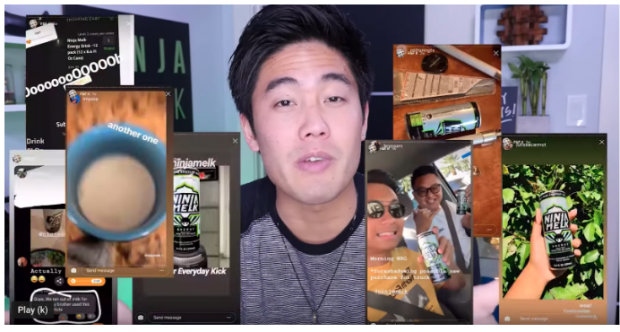
Pro tip: Don’t forget to say thank you. Because it’s polite. But also because it’s an excuse to remind people how great and popular your product is, one more time.
Create sponsored content
You don’t have to be on Instagram to be an influencer. The advantage of the #sponcon strategy is that you don’t have to give YouTube a cut of your earnings. You negotiate directly with the brand, and they pay you directly. No wonder it’s a popular way for YouTubers to make money.
If you can offer brands a large and/or engaged audience—and your content is relevant to their target market—they probably want to hear from you.
For instance, YouTuber Aaron Marino, a.k.a. Alpha M, is big in the men’s lifestyle space. How big? So big that even his videos that explain his brand partnerships have brand partners.
Step 1. Find a brand to partner with
Quality is important, when it comes to the names you work with. You probably already have a wish list of dream brands. Whether you’re aiming for the stars or building yourself up grassroots-style, make sure you perfect your brand pitch before you send it.
Also consider signing up with an influencer marketing platform. These are intermediary websites that help marketing teams find appropriate influencers to work with. FameBit was one of the first to focus on YouTubers, for instance.
Step 2. Make a deal
According to this recent study by influencer marketing platform Klear, YouTube videos are, on average, the most expensive type of sponsored content brands can buy from influencers. Basically, YouTube influencers are able to charge more for their videos than they would for Instagram Stories or Facebook posts, because video is just more expensive to produce.
While your rate will vary on your audience’s size, engagement and relevance to your potential partner, know your worth before you sign a contract.
Step 3. Be transparent about your #sponcon #ad
Sponsored content is advertising. That means you need to make sure you’re in step with Google’s Ad policies. The FTC (U.S.) and ASA (U.K.) both have guidelines of which you should be aware, too, if you’re American or British.
Transparency is good for your legal health, but also for your relationship with your audience. YouTube has a visible disclosure feature to help you make sure your audience is aware that you’re advertising to them.
Transparency is good for your legal health, but also for your relationship with your audience. YouTube has a visible disclosure feature to help you make sure your audience is aware that you’re advertising to them.
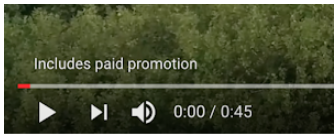
Get your fans to pay you directly
This strategy for making money on YouTube includes a few different income streams, but they all have one thing in common: you have to make it easy for your fans to show their appreciation with their credit card.
Step 1. Host live chats where people can use Super Chat
In early 2017, YouTube replaced their previous Fan Funding feature with Super Chat. This is a feature that is only available to YouTube Partners while they live stream.
Essentially, your viewers can make their comments more visible—they’re highlighted and pinned for a set amount of time depending on how much they pay—in the live chat stream.
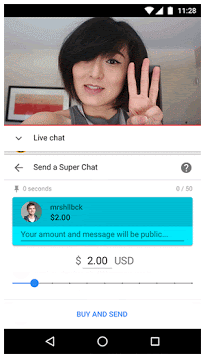
Step 2. Encourage your fans to become channel members
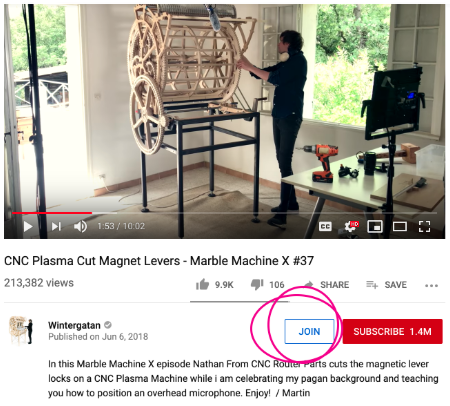
YouTube offers the ability to let your viewers pay you to become members of your channel. In exchange, they get custom emoji, badges, and access to members-only exclusives like Live Chats with you.
For instance, Wintergatan is a Swedish band that also makes elaborate marble machines and posts videos about it to their YouTube channel. They regularly thank their channel members in their videos. They also make it clear what the money from memberships supports:
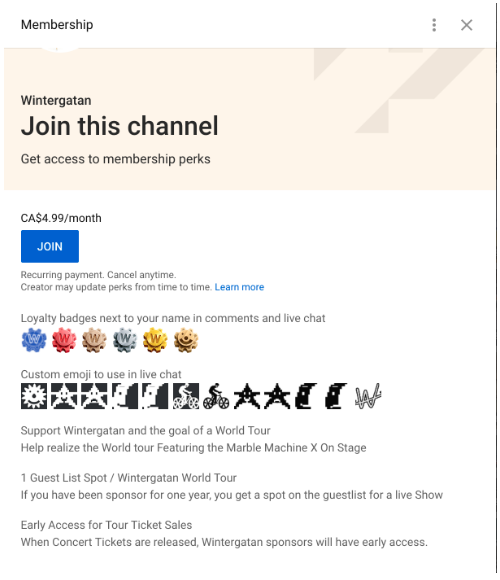
You’ll need to build out a promotion strategy to convince people to become members, which may or may not include several tiers of membership. Like Super Chat, this feature is only available to YouTube Partners.
Step 3. Encourage your fans to become YouTube Premium subscribers
This step is the last on our list for this strategy because it benefits your channel only indirectly. That said, when YouTube Premium members watch your channel, you get a cut of their subscription fee. (And so does every other channel they watch.)
Use crowdfunding on an ongoing or one-off basis
Soliciting donations online is now commonplace. Whether you’re looking to build ongoing revenue from a pool of small monthly donations, or looking to fund a personal, channel-related project, crowdfunding is how many YouTubers make money.
Step 1. Set up a crowdfunding account
YouTube has a list of approved crowdfunding sites to choose from.
For recurring funding Patreon is a top choice. Meanwhile, sites like GoFundMe or Kickstarter are best for one-off campaigns to get a new mic, or new laptop, or new … spleen.
Even household names like Walk Off the Earth or Veronica Mars (ok, she’s a fictional character) have used Patreon to fund their projects, be they music videos or feature-length films.
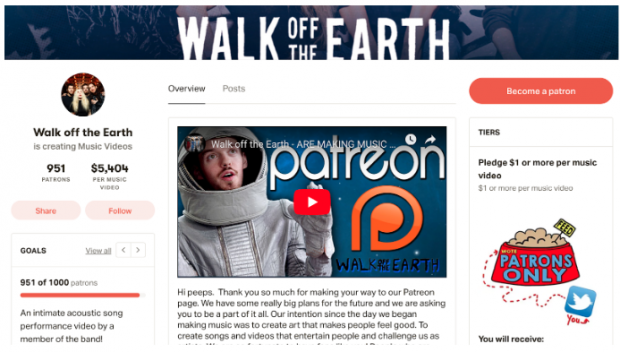
Step 2. Promote your campaign in your videos
Detail your specific goals so that people know exactly what they can expect when you’ve succeeded.
Also, offer enticing perks that stack as your fans choose how much they want to donate.
For more information and inspiration, check out this detailed guide to crowdfunding strategies.
Step 3. Go beyond YouTube
A successful campaign is a multi-platform affair. We have some advice on how to promote your YouTube channel (and by extension, your crowdfunding campaign) everywhere else.
License your content to the media
When a video goes viral, every news outlet wants to get their hands on a copy in order to replay it for their audience. Fortunately, established media companies are well aware that they need to pay for what they use. And voila, you’ve got yourself another way to make money on YouTube.
As a content creator, licensing your most successful work to the media can be as simple as making sure you’re easy to find.
Step 1. Keep your contact details updated on your About page
You never know when lightning will strike. Even if you don’t have a business manager, set up a generic email account that you can point to for business inquiries.
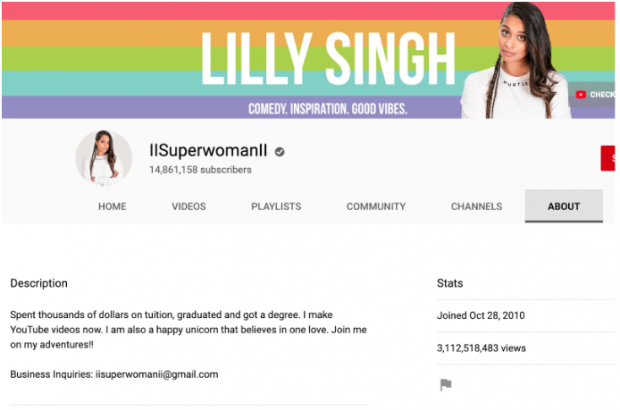
Step 2. Sign up to a video rights marketplace
Jukin Media is a great place to start. Even if you don’t have a viral video like the Chewbacca mask lady (see below), media outlets often need timely footage to round out their reporting.
For instance, Jukin has an entire catalogue of ‘newsworthy’ videos that you can contribute to, if you happen to have exclusive footage of a major natural disaster, plane crash, or plague of locusts.
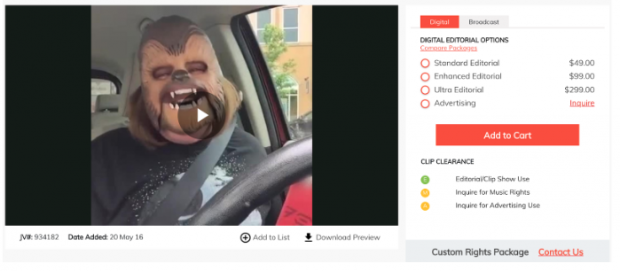
from Fruitty Blog https://ift.tt/2A0saad
via IFTTT
No comments:
Post a Comment